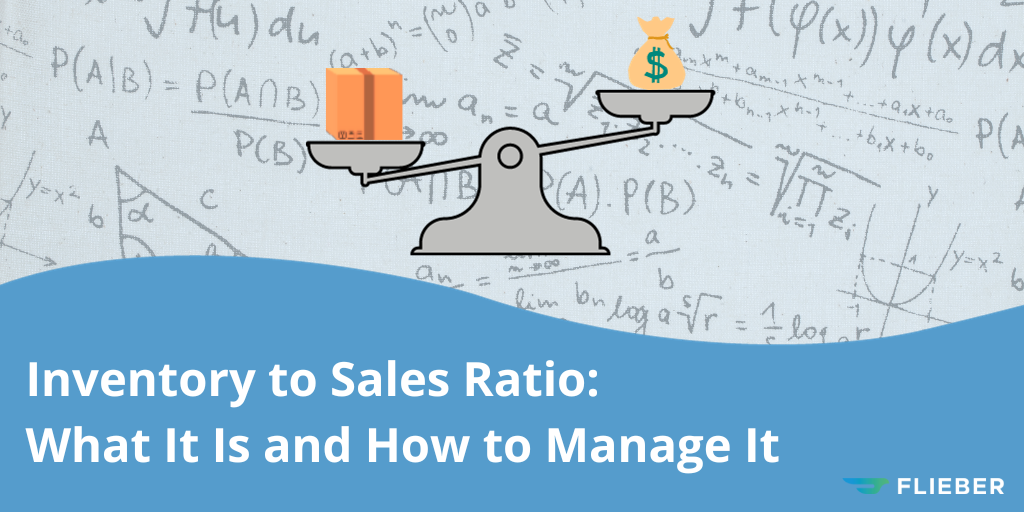As an online retailer, you know that managing your inventory levels efficiently is becoming ever more critical to your bottom line.
You can’t afford stockouts, but you also can’t risk tying up your capital in excess inventory. You have to find that Goldilocks “just right” number for each SKU.
One of the best ways to do that is to figure out your optimal inventory to sales ratio.
Your inventory to sales ratio, or I/S ratio, represents the relationship between the capital you’ve allocated to inventory and your total number of sales during a given period.
The lower your I/S ratio, the more efficient you are in allocating capital to inventory. But it can’t be too low, or you’re looking at an increased risk of low inventory or stockouts.
In this post, we’ll look at how to calculate your I/S ratio and compare it with other common inventory management KPIs. We’ll also explore ways to improve your company’s inventory planning so you can protect your profit margin and make sure you always have the right amount in stock.
Table of contents
- Calculating I/S ratio
- Inventory to sales ratio vs. inventory turnover ratio
- Inventory to sales ratio vs. daily sales of inventory
- How Flieber can help you make better inventory decisions
- Top FAQs about the I/S ratio
|
Inventory to sales |
Inventory turnover |
Daily sales of inventory |
|
|
Definition |
Measures average inventory value compared to net sales. |
Measures how often inventory is sold and replaced over a specific period, typically a year. |
Measures average number of days it takes to sell current inventory. |
|
Use Case |
Indicates how much inventory is on hand relative to sales, helping to assess if you have too much or too little inventory. |
Provides insight into the efficiency of inventory management. |
Helps businesses understand the liquidity of their inventory. |
Calculating your inventory sales ratio
The formula for calculating your I/S ratio is: Average Inventory Value / Net Sales.
To understand how to calculate your I/S ratio, let’s look at two companies, Pyllow and Drybl.
- Pyllow sells ergonomic neck pillows that costs $5 to produce and are sold for $20. During the last 30 days, Pyllow sold 5,000 units, generating $100,000 in sales. In the same 30 days, they carried an average of 5,000 units in inventory, at a total cost of $25,000.
- Drybl sells water purifiers, with the same cost of $5 and sales price of $20. During the last 30 days, Drybl sold the same 5,000 units, generating the same $100,000 in sales. But unlike Pyllow, during this period it carried an average of 10,000 units in inventory, at a total cost of $50,000.
Let’s apply the I/S formula to our two examples:
- For Pyllow, the I/S ratio is $25,000 / $100,000 = 0.25
- For Drybl, the I/S ratio is $50,000 / $100,000 = 0.50
This means that for every $1 sold, Pyllow had 25 cents invested in inventory. On the other hand, Drybl had invested 50 cents for every $1 sold — two times more than Pyllow.
Remember, both companies sell a product with the same cost and the same sales price, and the only variation here was in the inventory level.
Now let’s add a third company, Kalë to the example.
- Kalë sells the supergreen gummies, with the same cost of $5 and sales price of $20. During the last 30 days, Kalë sold the same 5,000 units, generating the same $100,000 in sales. The only difference between Kalë and the previous companies is that Kalë carried an average of 2,500 units in inventory, at a total cost of $12,500.
We’ll apply the same formula of Average Inventory Value / Net Sales:
- For Kalë, the I/S ratio is $12,500 / $100,000 = 0.125
For every $1 sold, Kalë needed only 12.5 cents invested in inventory, which is half of what Pyllow needed and just one-fourth of what Drybl needed.
That might seem great, but here’s the catch: to carry an average of 2,500 units in stock during the month means that its beginning inventory was 5,000 units and ended with 0 units. In other words, Kalë ran out of stock.
What is the right I/S ratio?
Kalë is a great example of why you shouldn’t aim for the lowest I/S ratio, but the healthiest one.
When it comes to inventory, you should always try to keep the right balance. If you’re overstocked, you are investing more capital than you need to and could even risk ending up with high amounts of dead stock that reduce your profit margins. But if you try to keep that investment as low as possible, you risk being out of stock.
For most growing e-commerce businesses, the right I/S ratio falls somewhere between 0.167 and 0.25.
But a higher number could still be a healthy benchmark if you’re scaling rapidly. It all depends on your industry, rate of growth, and any number of other variables.
Inventory to sales ratio vs. inventory turnover ratio formula
To be clear, your I/S ratio formula is not the same as your inventory turnover ratio formula.
The inventory turnover ratio measures how many times you sell and replace your stock within a given period of time. It’s determined by dividing the cost of goods sold (COGS) by the average value of inventory within a timeframe. It is often, but not always, calculated by year.
The formula for inventory turnover ratio is: COGS / Average Value of Inventory
To break down this formula further:
- COGS = Beginning Inventory + Purchases - Ending Inventory
- Avg Value of Inventory = (Beginning Inventory + Ending Inventory) / 2
The resulting number gives you a sense of how fast your company is moving its inventory. In general, a higher ratio is a good thing — it means you’re making a lot of sales, relative to what you’re spending on inventory.
But in some cases, it could also mean you’re stocking out often, so the inventory turnover ratio is not an ideal measure of inventory efficiency on its own.
To achieve a healthy balance of stock and sales, most e-commerce businesses aim for an inventory turnover ratio between 4 and 6.
For the above example, in a future month Pyllow’s COGS is $22,500 due to purchases of inventory. The average inventory during that same timeframe was valued at $4,500 as they started with $6,000 in inventory and ended with $3,000. With these factors, the inventory turnover ratio would be:
- COGS / Average Value of Inventory = $22,500 / $4,500 = 5
Putting Pyllow’s inventory turnover ratio at 5, an ideal figure for a healthy DTC brand — at least for that particular month.
What’s the functional difference between I/S ratio and inventory turnover ratio?
I/S ratio and inventory turnover ratio are two important ratios with two very different end goals.
Inventory turnover ratio is a solid formula for understanding whether you’re making enough sales and a useful metric in determining whether your business is performing well on the whole.
I/S ratio, on the other hand, is calculated using your net sales values. It gives you a better understanding of how efficient you are at allocating capital to your inventory, with respect to your revenue. Since this is crucial to a healthy balance sheet, your I/S ratio is considered a more straightforward tool for determining how best optimize your company’s sales and inventory.
Both of these formulas are useful guidelines, but neither is particularly handy for the kind of sophisticated demand forecasting more e-commerce businesses need today.
Inventory to sales ratio vs. daily sales of inventory
Daily Sales Inventory, or DSI, is the average number of time, in days, that it takes to sell all the inventory you have in stock. It’s useful for calculating how long it will take you to clear the inventory you’re currently carrying.
The formula for DSI is: Average Inventory Value / Cost of Goods Sold x 365 days.
While the I/S ratio helps you figure out whether you’re ordering goods in the right quantities, DSI is a measure of the pace at which inventory moves through your company.
With an I/S ratio, you always want to get the lowest possible number without causing costly stockouts. With DSI, numbers can vary widely depending on what industry you’re in.
This is mainly because DSI depends highly on the type of goods sold. For example, perishable goods clear much faster than items like furniture or appliances.
Applying the formula for DSI for Pyllow in the same month for the last example, we’d get:
- Average Inventory Value / Cost of Goods Sold x 365 days
- $4,500 / $22,500 x 365 days = 73
We get a DSI of 73, meaning it takes Pyllow about 73 days to clear all its inventory. A good DSI is usually between 30 and 60 for most industries, so Pyllow could probably stand to carry a bit less inventory throughout the year.
How Flieber can help you make better inventory decisions
Most companies rely on basic formulas like those above, where a few simple equations determine your entire forecast.
Some of the more sophisticated tools or methods may also account for other regularly anticipated fluctuations — like higher Q4 demand — using a percentage you can add or deduct when demand is expected to shift.
The problem is, this kind of inventory planning doesn’t account for all the other variables that impact your sales — like patterns in seasonality, supply chain challenges, shifting trends, or sales boosts due to successful marketing campaigns.
This is because most demand planning systems don’t offer real-time visibility into all the avenues where you sell. They can’t help you navigate when sudden outliers throw your forecasts off-track.
With Flieber’s customizable forecasting and advanced AI algorithms, you get complete visibility into your sales, inventory and supply chain, to help you meet customer demand while minimizing storage costs and stockouts.
You control what you see and can use your forecasts to get as broad or granular as you need, customizing for:
- Predicted growth
- Testing scenarios
- Product comparisons
- Planned marketing events
- Outliers and other variables
With Flieber, you can plan for every scenario with just a few clicks to make sure you always have just the right amount of inventory on hand.
Top FAQs about the I/S ratio
To recap, here are some answers to commonly asked questions about I/S ratio and other key inventory planning formulas.
What is inventory to sales turnover ratio?
When people ask what “inventory to sales turnover ratio” is, they’re typically describing two different inventory planning formulas.
Inventory to sales ratio, or I/S ratio, which represents the ratio of allocated capital to sales volume, and is calculated with the formula:
- I/S ratio = Average Inventory Value / Net Sales
Inventory turnover measures how frequently your inventory turns in a given period. It’s calculated using the formula:
- Inventory turnover ratio = COGS / Average Value of Inventory
For a more in-depth explanation of these formulas, click here to scroll up to the top of this article.
What is the formula for inventory to sales ratio?
The formula for inventory to sales ratio, or I/S ratio, is:
- I/S ratio = Average Inventory Value / Net Sales
Why is the inventory to sales ratio important?
Inventory to sales ratio measures how much stock you need to carry to mitigate the risk of stockouts without allocating too much capital to inventory.
What's a good inventory to sales ratio in e-commerce?
A good inventory to sales ratio in e-commerce is typically between 0.167 and 0.25.
Get more control over your inventory
As an e-commerce leader, you know it takes more than a few simple equations to master your inventory planning.
Flieber is the modern inventory planning platform specifically designed for multichannel retailers with complex product portfolios, lead times, and sales patterns.
Control your inventory, your way. Learn more about how Flieber works by scheduling a demo today.



-1.png)

